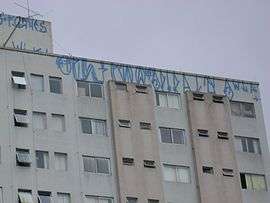Pichação

Pichação,[1][2] sometimes misspelled[3][4] as pixação (Portuguese pronunciation: [piʃaˈsɐ̃w̃]), is the name given to graffiti in the Southeastern metropolises of São Paulo and Rio de Janeiro, in Brazil. It consists of tagging done in a distinctive, cryptic style, mainly on walls and vacant buildings. Many pichadores (pichação painters) compete to paint in high and inaccessible places, using such techniques as free climbing and abseiling to reach the locations. Pichação is mostly condemned both by the society and the government since it is a crime. However, there is a difference between pichação and graffiti in Brazil, with graffiti being considered a form of art (as long as the property's owner agrees to have the wall graffited), and pichação not, often including rude and sexual themes.
History
Pichação, known also as "wall writings", began in the 1940s and 50s as political statements written in tar and "were often written in response to the slogans painted by political parties across the streets."[5] "Piche" is the Portuguese word for pitch or tar, and pichação originally meant writing in pitch. In the 1970s, pichação almost disappeared, but it was revived in the 1980s by a group of youths who began writing their names, and the names of their crews, instead of political slogans.[5]
Pichação has been described as a "vehicle for the youth of the city to assert their existence and self-worth, and to do it loudly. As a social protest, Pichação is brutal, effective and pulls no punches. There is no country on earth with a worse distribution of wealth than Brazil. For the rich, there are nice buildings. For the poor, there are shanty towns. Pichação exists on the very surface of the contested wealth, and promises to keep on punishing the fortunate until they produce a world less punishing to begin with."[5]
Methods
Although its name is derived from the word for tar, many of the "pichadores" (those who do pichação) in São Paulo use a 2-3 inch foam roller, spray paint and latex paint; it is what is known in English-speaking countries by the Italian word "graffiti". In other cities, such as Rio de Janeiro, pichadores use only spray paint. Many pichadores write their crew name, while others write their own individual name. The letters are usually of equal height and spacing, although technique varies in different cities around Brazil. Although the lettering originally reflected the typography of eighties heavy metal record covers, the styles have evolved over time.[5]
Pichadores often compete to tag the tallest, most dangerous, and most noteworthy locations. One example of this is the group Os Diferentes, who tagged the internationally-known Christ the Redeemer statue in Rio de Janeiro. They were caught and arrested, but bragged about it the next day.[5]
References
- ↑ Aulete Dictionary: pichação
- ↑ Priberam Dictionary: pichação
- ↑ UOL Educação: "Pichador" derives from "piche" (in Portuguese)
- ↑ Dúvidas de português: Piche or pixe (in Portuguese)
- 1 2 3 4 5 Manco, Tristan, Lost Art, and Caleb Neelon; "Graffiti Brasil", Thames & Hudson, London, 2005 ( ISBN 0-500-28574-8)
External links
| Wikimedia Commons has media related to Pichação. |
- Siwi, Marcio (January 6, 2016). "Pixação: the story behind São Paulo's 'angry' alternative to graffiti". The Guardian.
- What is pichação? From the Juxtapoz magazine special Brazil issue.
- www.seidaris.de German artist analyzing Pichação and interpreting it into western form.
- Pichação videos we love: pichação's barbarian alphabet